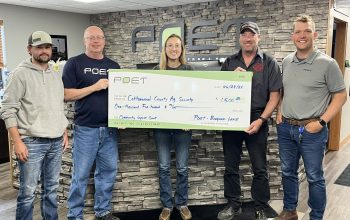As the presidential election looms just days away, one hopes that most adults are planning to vote or have voted. This political process is an important American right that most of us start learning about years before we can actually take part in it. Recently, students at Clarion-Goldfield-Dows not only learned about elections, but they also had the opportunity to take part in the process thanks to a big project.
This project took place in Adam Vorrie’s middle school classes. Vorrie teaches 7th grade global studies and 8th grade US History and Civics. He broadly titled the project “Election Simulation.” Vorrie explained the goal of the unit is to teach the students about government by “replicating as closely as we can the electoral process.”
Essentially, the project sets up a governing body in the middle school. This is complete with political parties, a president, senators, representatives, governors, all elected by voters- the student body.
To accomplish this, Vorrie closely simulates within his classes many of the facets of real elections. Students interested in running for office had to gather signatures and fill out paperwork to get on the ballot. Students were given “money” which they could donate to candidates. Vorrie adds he randomly gave some students larger amounts of money to mimic wealthy donors. He said that this helps students learn about campaign financing. Students could even form PACs and Super PACs. Vorrie said this opened students’ eyes to how to “play within the rules of the system.”
He explained that each class functioned as a state with a governor who drew up congressional districts using the seating chart. He says that when some governors started drawing up districts that were advantageous to their friends, it was a good opening to talk about gerrymandering.
After the ground rules were put in place, several students ran for office. There were three presidential candidates, plus over 15 more running for senate and house. Students ran full-fledged campaigns with fliers, stump speeches and even TV ads if they wanted to ‘pay’ for them. Class governors ran the elections, setting place, time and requirements. Vorrie noted that when a few governors required lunch ID cards to vote, and some students couldn’t locate theirs, it was again a good opportunity to talk about voter ID laws.
The election was recently held, and the winners arose victorious. The ramifications of the project are far from over though. Vorrie says the election simulation was not just a classroom exercise but rather a real election of a middle school student government. Essentially a student council!
Both Vorrie and Middle School Principal Steve Haberman agree that they hope the student government has a real impact. “They will actually be able to act on this!” says Vorrie. “We hope the student government will be able to use real money to plan events like dances or address issues in the school and community.”
Haberman stated, “We hope this will promote more student leadership in the school. We wanted them to have ownership of ideas and plans, so we’re excited to see what they can get done.” He also confirmed, “Our student government will be focused on projects that have to do with both school and community improvement and work closely with our Peer Helper program. If you have an idea for the student government, please let us know!”
In the end, Vorrie is pleased with how the students responded to the project. “The whole thing led to really high-quality discussions as we looked at the system. I think they learned a lot.” He reported that the exams he gave on the election unit were some of the best he’d ever graded, suggesting that the material really sank in.
Vorrie summarized, “This was meant to be more than just a token project. We’re really trying to empower them. It’s early, but I’m looking forward to seeing what they accomplish.”


